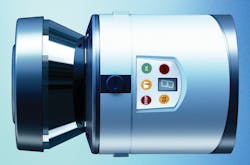Remember the days of the simple photo-electric cell? Using either a transmitter-receiver pair or a single TX/RX with a retro-reflector, the interruption of an IR beam would trigger an alarm, stop a process, or simply act as an input to another process. We have come so far!
Today, using laser technology, a beam can be emitted into free space, reflect off an object, and, upon returning, provide the input to calculate distance of the object based on its flight time. Compound that with the fact that the beam is scanning continuously over a pre-determined arc travelling at 386,000 miles per second and you’ve got something interesting.
Some refer to this technology as LIDAR (Light Detection and Ranging), based on the same concept as RADAR, but using laser light instead of radio waves. Because laser light is higher in energy and shorter in wavelength than radio waves, it reflects better from non-metallic objects and provides mapping advantages over RADAR.
Already, there are high-profile applications where laser ranging technology is considered a baseline technique for measurement, such as geo-spatial imaging. In conjunction with GPS, laser scanners from an aircraft can accurately determine the height of the ground, peering through foliage and atmospheric moisture to provide a detailed profile of a geographic area.
Those pulses being shot from a state trooper’s speed gun that didn’t register on your radar detector — you guessed it, that’s LIDAR. Our future society may have autonomous self-driving vehicles where laser technology helps them calibrate distance to adjacent objects, drawing a virtual map of its surroundings.
The puzzling thing is that this technology has been available for years — it has been used in U.S. industrial and traffic applications ranging from gauging to tolling — but it is not mainstream in security. However, the laser’s distance capability creates several intriguing possibilities for security sensors.
Coupled with software that paints virtual boxes in an area to be scanned, a system can tell if someone has entered an area, just by whether or not there’s a reflection of a scanning beam that meets the box’s flight-time criteria for reflected energy.
The radiated energy can be over a range of wavelengths, but, for security, infrared is obviously better (remember the old spy movies where the bad guys crawl under the photo-electric beams to steal the museum masterpiece). A laser manufactured by the German company Sick, sold by Comtrol Corp., in the United States, uses 905 nm — slightly higher than the 850 nm commonly used in fiber optic systems. Maximum rage is typically expressed as that where there is 10 percent reflectivity and can reach about 200 feet over an arc of 180 degrees. Outputs can be contact closures, serial or network-based.
Indoor security applications would usually be volumetric, although the laser effectively creates a two-dimensional “slice” of the area. If, for example, the laser was ceiling-mounted, shooting towards a wall, anything breaking the slightly angled plane of the beam would be a candidate to register in the accompanying software. If the laser scanner was mounted to scan parallel to a wall, it could determine if someone were reaching for any object on the wall — making it useful for retail applications, museums, art galleries, etc.
The technology also has applications in people counting and monitoring of restricted or hazardous areas. The advantage of the laser vs. PIR or microwave is the ability to determine the intrusion and its position. The advantage is further enhanced by the accuracy and granularity of the sensor, as well as multiple zones.
A scanner head can sell for several thousand dollars, depending on range and software options, but costs have come down over the last several years.
Outdoor applications can be volumetric or linear, such as for placement along a perimeter. Because these sensors can be environmentally hardened, they have already found use in applications such as tolling barriers on highways. Based on the positioning of the scanner, they can detect objects or people only above or below a certain height, eliminating ground clutter and small animals. While range is limited, scanners can be complemented by other technologies such as video surveillance.
Perhaps because of my own background in fiber optics, I was able to quickly see, from a technical standpoint, how these laser sensors could be quite useful in security. Given their use in security applications across Europe, as well as in domestic non-security applications, I’m quite surprised this technology has not been mainstreamed here for security. The opportunity is there.
Ray Coulombe is Founder and Managing Director of SecuritySpecifiers.com, enabling interaction with specifiers in the physical security and ITS markets; and Principal Consultant for Gilwell Technology Services. Ray can be reached at [email protected], through LinkedIn or followed on Twitter @RayCoulombe.
About the Author
Ray Coulombe
Ray Coulombe is founder of SecuritySpecifiers.com, the industry’s largest searchable database of specifiers in the physical security and ITS markets. He is also Principal Consultant for Gilwell Technology Services. He can be reached at [email protected] or through LinkedIn.

